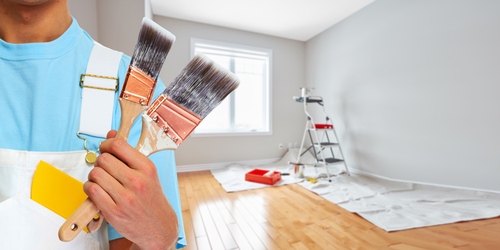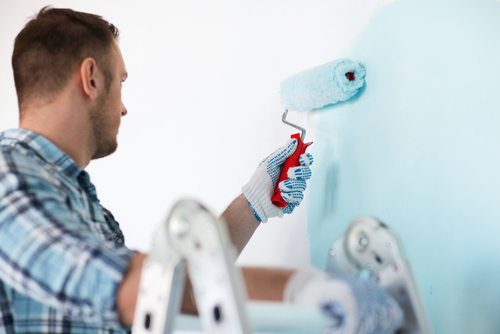Should I let my tenant paint their rental property?
When you own rental properties, you may find yourself asking this question. For some landlords, this question leads to an automatic “no.” However, you may want to consider the pros and cons first. Today, we’ll review why some tenants want to paint, the pros and cons of letting your tenant paint, and how to create a landlord-tenant painting agreement.

Contents of This Article:
- Should I Let My Tenant Paint Their Rental?
- Pros and Cons of Letting a Tenant Paint
- Create a Landlord-Tenant Painting Agreement
- What Happens If a Tenant Paints Without Asking?
- Maintain Your Properties With BMG’s Services
Should I Let My Tenant Paint Their Rental?
One of the most controversial questions amongst landlords is, “Should I let my tenant paint their rental property?” Many landlords will give an immediate “no” for an answer. However, some may genuinely consider giving their tenants the option. Ultimately, it’s up to you and your preferences.
On one hand, allowing a tenant to paint gives them a bit of freedom and helps them settle into their homes. After all, many tenants value the ability to personalize their living space, and it can also make them stay longer at your rental.
On the other hand, it can cost a landlord more to revert the changes or assess potential damages from an unprofessional paint job.
If you are debating whether or not to let your tenant paint, read along as we discuss some pros and cons. Then, we’ll go over how to create a landlord-tenant painting agreement to ensure you, your tenants, and Baltimore property managers are on the same page regarding tenant painting procedures.
Pros and Cons of Letting a Tenant Paint
Tenants like having the freedom to make their rental property feel more like home. One of the best ways to do this is by painting the walls in the colors of their choosing. However, while this can help tenants settle into a home, it can also create issues for landlords. After all, not all tenants are professional painters, which can lead to property damage. Before allowing tenants to paint their rental, read more about the pros and cons.
 Benefits of Letting a Tenant Paint
Benefits of Letting a Tenant Paint
- Increased Tenant Satisfaction- Allowing tenants to personalize their living space through painting can lead to higher satisfaction and a stronger sense of ownership over their rental. In turn, this can lead to them treating the property better.
- Competitive Advantage- Offering the option to paint might make your rental more attractive compared to others in the market. It could give you a competitive edge in attracting and retaining tenants.
- Higher Rent Potential- If tenants are willing to invest time and effort into painting the unit, they may also be willing to pay slightly higher rent for the privilege. In turn, this could potentially increase your rental income.
Disadvantages of Letting a Tenant Paint
- Potential Damages- Not all tenants are experienced or careful painters. If they have no experience painting, there’s a risk of damage to walls, floors, or fixtures if the painting is done poorly or improperly.
- Color Choices- Personal taste in paint colors can vary widely. For instance, tenants may choose colors that are too bold or unconventional, making it harder to revert the changes or attract future tenants who don’t share the same taste.
- Uneven Paint Job- Even if tenants have the best intentions, they may not have the skills or tools necessary to create a professional-looking paint job. This may result in uneven coats, drips, or other imperfections that take away from the property’s appearance.
Create a Landlord-Tenant Painting Agreement
 Suppose you’ve weighed the pros and cons of letting a tenant paint their rental unit, but you’re still not convinced. There are a few ways to make the situation more attractive for landlords while still providing the freedom to let your tenant paint their rental units. Here are a few things you can do to create a mutual landlord-tenant painting agreement to add to the lease.
Suppose you’ve weighed the pros and cons of letting a tenant paint their rental unit, but you’re still not convinced. There are a few ways to make the situation more attractive for landlords while still providing the freedom to let your tenant paint their rental units. Here are a few things you can do to create a mutual landlord-tenant painting agreement to add to the lease.
- Charge a Fee to Paint the Property
- Revert Painting Changes
- Hire Professional Painters
- Limit How Much They Can Paint
Charge a Fee to Paint the Property
Allowing a tenant to paint their rental unit can be a liability. After all, if they’re inexperienced, it can lead to damage or a horrible-looking paint job that’s hard to fix once they move out. To compensate for these risks, you may want to charge a fee for painting. That way, when the tenant moves out, you can use the money to repaint the space or fix any damages they may have caused.
Revert Painting Changes
Another popular rule or guideline to include in your landlord-tenant painting agreement is to revert the changes once the lease term is over. This creates an uncomplicated solution to allowing a tenant to paint. Your current tenant can temporarily personalize their space, and the next tenants will have a clean slate. Then, if they don’t revert the changes, you can subtract the cost from their security deposit.
Hire Professional Painters
Since not all tenants are professional painters, you may want to hire a professional contractor to revert the changes made by a tenant. You can also require a tenant to hire a professional painter to help them with any changes they want to make. That way, you lessen the risk of damage or a bad paint job. Additionally, hiring a professional to revert the changes can help make the property more attractive to your next prospective tenants.
Limit How Much They Can Paint
Finally, just because a tenant asks to paint doesn’t mean you have to let them paint the entire rental unit. You can limit how much they can paint or which walls you want them to paint. For instance, instead of painting an entire room, give them the option to paint one accent wall. Or, instead of painting each room, allow them to paint only one or two rooms. That way, when they move out, you don’t have to worry about repainting the entire property.
 What Happens If a Tenant Paints Without Asking?
What Happens If a Tenant Paints Without Asking?
Most tenants will ask before making any major changes to a rental property. However, not all tenants have the same respect for landlords. You may come across a tenant who makes major changes, like painting the walls in a rental property, without asking permission first. So, what do you do in this scenario?
First, you’ll want to review your lease agreement to see what it says regarding alterations or modifications to the property. If the lease explicitly prohibits painting without permission, the tenant is technically in violation of the lease terms.
When a tenant violates your lease terms, you’ll want to address the situation and discuss the unauthorized painting. This may include requiring them to restore the property to its original condition at their own expense or deducting the cost of repainting from their security deposit at the end of their tenancy.
Maintain Your Properties With BMG’s Services
If you’re wondering, “Should I let my tenant paint their rental property?” just know that you’re not alone. While some landlords aren’t willing to take the risk, some will allow their tenants to personalize their living space by painting the walls. Ultimately, it’s up to you and your preferences as a landlord!
Need More Advice? contact us today!
If you want to keep your rentals in the best shape possible, consider hiring a comprehensive property management company like BMG. Bay Property Management Group can help you find great tenants, create thorough lease agreements, and ensure your properties are well taken care of. Contact us today to learn more about our services throughout Baltimore, Philadelphia, Northern Virginia, and Washington, DC.

 Benefits of Letting a Tenant Paint
Benefits of Letting a Tenant Paint What Happens If a Tenant Paints Without Asking?
What Happens If a Tenant Paints Without Asking?